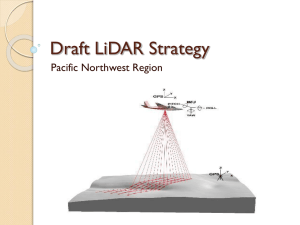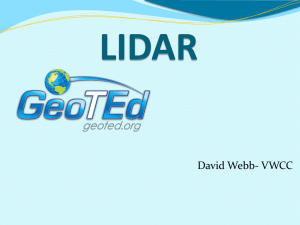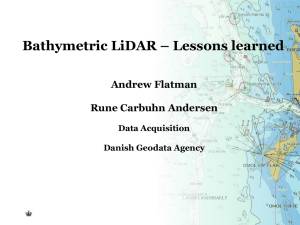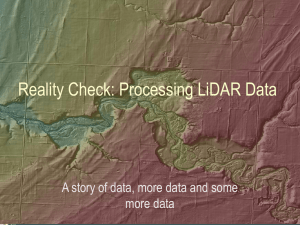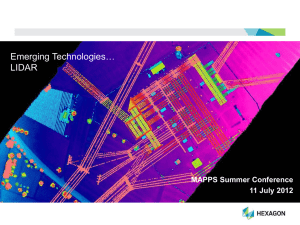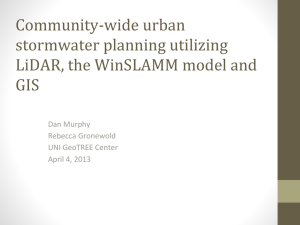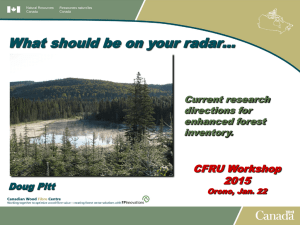Hydro-enhancement of LiDAR Data to Support Floodplain Modeling
advertisement
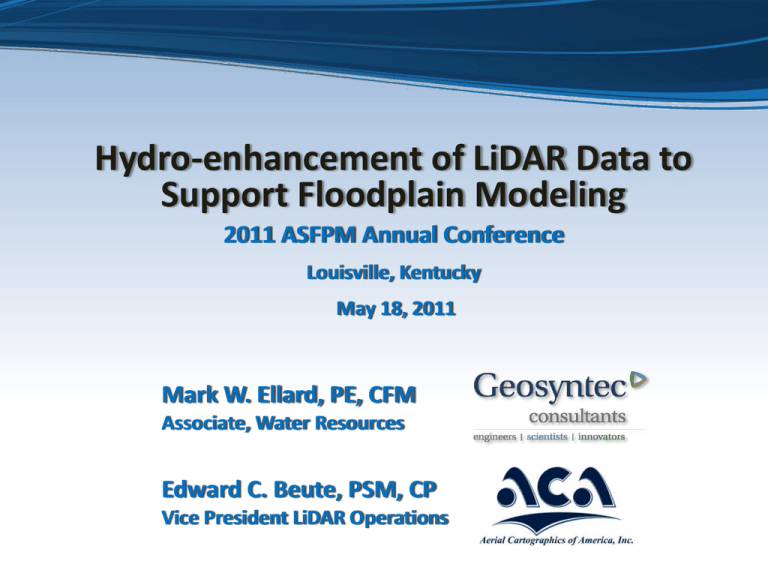
Hydro-enhancement of LiDAR Data to Support Floodplain Modeling 2011 ASFPM Annual Conference Louisville, Kentucky May 18, 2011 Mark W. Ellard, PE, CFM Associate, Water Resources Edward C. Beute, PSM, CP Vice President LiDAR Operations Presentation Outline Role of LiDAR in Watershed Modeling Hydrological Representation of LiDAR Issues with LiDAR & Modeling LiDAR Data Collection & Classification Overview LiDAR Hydro-enhancement Modeling Results Impact Role of LiDAR in Watershed Modeling • Detailed Surface Representation • Digital Data Source • Easy to Update Incrementally (i.e., New Development, etc.) • Easy to Take for Granted Role of LiDAR in Watershed Modeling Flood Model Foundation Hydrological Representation of LiDAR • GIS Processing for Model Parameterization – Catchment / Basin Delineation – Storage Extraction – Cross-section Extraction – Flow Path Tracking – Floodplain Inundation Issues with LiDAR & Modeling • Conditions in Florida that Cause Problems – Non-Dendritic Watersheds – Flat Topography – Thick Vegetation Obscures Ground Surface • Misrepresentation of Storage – Lakes / Ponds – Initial Stages – Sloped Water Surfaces (rivers, canals, etc.) – Affects Estimates of Floodplain Depth • Misrepresentation of Conveyance – Channels – Overland Flow – Inaccuracies in Floodplain Depth and Flow Issues with LiDAR & Modeling Issues with LiDAR & Modeling Issues with LiDAR & Modeling Issues with LiDAR & Modeling Survey Enhancement of Conveyance Features (Ditches, Canals, etc.) LiDAR Data Collection & Classification Overview LiDAR Collection Process • Laser scanner, Survey Grade GPS Receivers, Inertial Measurement Unit (IMU), Aircraft • Processing Computers, Proprietary Software • Collection is project specific which determines altitude, ground speed, pulse rate repetition, and point density. • Every project must have a boresite calibration flight LiDAR Data Collection & Classification Overview LiDAR Data Collection & Classification Overview LiDAR Processing • Data extraction • Processing of trajectory for position and orientation of the sensor • Pre-processing data using proprietary software • Output data in LAS format in project specific coordinates and units LiDAR Data Collection & Classification Overview Classification Process • Off The Shelf (TerraScan) or proprietary software • Automated Routines using a set of parameters designed to model the bare earth ground and other useful information • Terrain specific parameters • Allows for batch processing of a project LiDAR Data Collection & Classification Overview Classification Process • Automated routines will correctly model most of the project • Some conditions do not meet the criteria set up in the automated routines • Labor intensive manual classification is necessary for the remainder • It is labor intensive is necessary where conditions for automated routines are not met LiDAR Data Collection & Classification Overview Classification Process Some common errors: Over filtering the data • data is smoothed showing no artifacts • valuable ground information is missing Under filtering the data • data is noisy due to artifacts • Non-ground added to the ground Modeling is compromised in both scenarios LiDAR Hydro-enhancement LiDAR Hydro-enhancement Original Data Enhanced Data LiDAR Hydro-enhancement Classifications as Delivered Orange = Bare Earth LiDAR Hydro-enhancement Classifications after Hydro-enhancement Orange = Bare Earth LiDAR Hydro-enhancement Classifications as Delivered Orange = Bare Earth LiDAR Hydro-enhancement Classifications after Hydro-enhancement Orange = Bare Earth LiDAR Hydro-enhancement Classifications as Delivered Classifications after Hydro-enhancement LiDAR Hydro-enhancement Classifications as Delivered Classifications after Hydro-enhancement LiDAR Hydro-enhancement Classifications as Delivered Classifications after Hydro-enhancement LiDAR Hydro-enhancement LiDAR Hydro-enhancement Points to Consider • Examine the data for suitability by identifying holidays, voids, and point density • Consider enhancement of data through reclassification to obtain additional ground points, identify structures and separate vegetation by height • Supplement or create new 3D break lines using Direct Terrain Extraction techniques (QCoherent LP360, Cardinal Systems VrLiDAR) Modeling Results Impact Modeling Results Impact Modeling Results Impact Modeling Results Impact Modeling Results Impact Modeling Results Impact • Example Conveyance Feature Modeling Results Impact • Example Conveyance Feature Modeling Results Impact • Model Node Stage Impact • Higher Flood Risk Indicated Enhanced Original • 100 Year – 72 Hour Simulation: Time – Stage Plot Conclusions • LiDAR plays an Important Role in Current Floodplain Modeling Efforts • Proper Classification of Ground Points is Critical – Properly Define Conveyance ways – Properly represent Storage • Hydro-enhancement Improves Surface Representation • Better Representation Increases Model Accuracy Mark Ellard, PE, CFM Associate, Water Resources mellard@geosyntec.com Thomas Amstadt, PE, CFM Professional, Water Resources tamstadt@geosyntec.com Edward Beute, PSM, CP Vice President LiDAR Operations e_beute@aca-net.com
